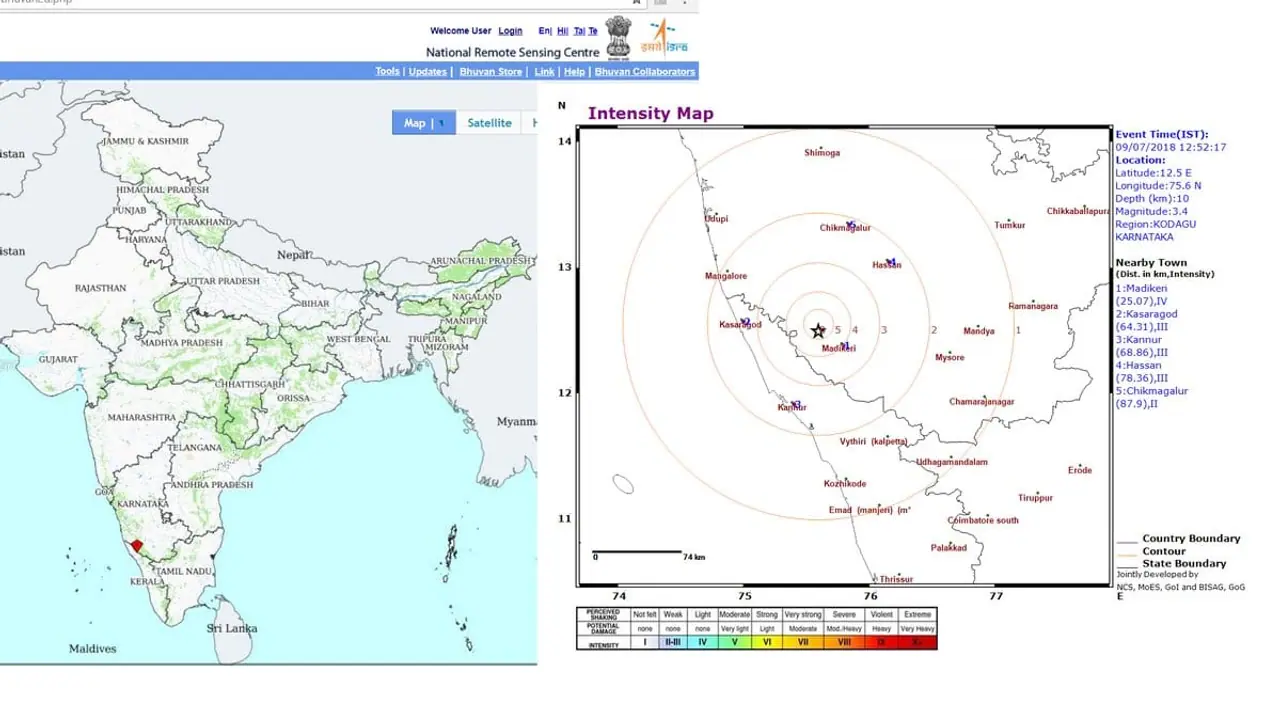According to the report, the quake line had passed through Madikeri, Bisale, NR Pura and Chikkamagaluru in Karnataka. But what's strange is that places in Kodagu region that experienced floods recently are the same areas that were jolted by the quake in July.
The report of National Remote Sensing Centre (NRSC) lists down the details of the earthquake measuring 3.4 on the Richter scale that affected Kodagu, Hassan, Chikkamagalur and also some areas in the neighbouring state of Kerala on July 9.
According to the report, the quake line had passed through Madikeri, Bisale, NR Pura and Chikkamagaluru in Karnataka. But what's strange is that places in Kodagu region that experienced floods recently are the same areas that were jolted by the quake in July.
Was this report considered by the Karnataka government as a warning sign considering the fact that such a quake is capable of triggering landslides? Kodagu floods have resulted in the death of more than 300 people and properties worth crores have been destroyed.
An earthquake loosens the soil, especially in the forest belt.

Even before NRSC report was out, in 2011, Madhav Gadgil committee had warned that at least 142 taluks (sub-division) across Western Ghats (along Karnataka and Kerala) should be declared highly sensitive areas (Ecologically Sensitive Zones -ESZ) and all commercial activities including quarrying, sand mining, dams or power plants (also cutting of forests) should be stopped immediately.
But this report was dubbed as pro-environment and anti-development. It was shelved and another committee headed by Kasturirangan was formed, which again submitted its report in 2013. This committee too said that 123 villages should be moved from the Western Ghats as it is a dangerous and sensitive area declared as ESZ.
ALSO READ:Kerala floods: Who is responsible for disaster - man or supernatural powers?
Among these 55 taluks in and around Kodagu, Emmethalu, Meghathalu, Athihole and Iggodlu (mentioned as sensitive areas in Kasturirangan report) have faced the worst landslide ever. To add to this, another warning was given by the Geological Survey of India (GSI) way back in 2016. Its report stated that about 12.6 per cent of the total land mass of India is landslide-prone. The report also has details of the (larger)areas that will be affected - 0.09 million square kilometres in Western Ghats and Konkan hills in states like Tamil Nadu, Kerala, Karnataka, Goa and Maharashtra.
It should be noticed that most of the land, hills affected by flood and landslide in Kerala and Karnataka (Kodagu), both fall under Western Ghats.
However, the Revenue Department (Disaster Management) of Karnataka has stated that the according to Indian Meteorological Department (IMD), earthquake measuring 3.4 in Richter scale was of low magnitude and there was no warning of landslides or heavy rains. The department also stated that scientist Raghavan from National Geophysical Research Institute, Hyderabad, visited Kodagu, conducted field visits to survey the area and had also set up a temporary seismic monitoring observatory at Navodaya school located about 8 km from Madikeri to closely monitor seismic activity in and around Kodagu.
Geeta Agnihotri, director, IMD, Bengaluru, said, "An alert was sent 2 days before the rains lashed Kodagu. Notice regarding heavy rains was sent on August 15. Kodagu was flooded on August 17."
The epicentre of the July 9 tremor carries light intensity with potential damage none, the IMD notice stated. The Karnataka government claimed that it sent the report immediately to Karnataka State Natural Disaster Monitoring Centre (KSNDMC) and was also forwarded to Kodagu district administration. On July 25, the nodal agency monitoring geotechnical aspects in the region reportedly visited Kodagu to study the tremor felt on July 9.
The government, in its reply, also said, "Earthquake-induced landslides generally occur immediately after tremor. Moreover, further north, Koyna region in Sahyadri mountains (also part of Western Ghats) which has similar tectonic, geologic and geographic environment, experiences frequent low magnitude tremors, which does not trigger landslides. It is clear that the landslides have been induced due to prolonged high intensity rainfall occurred in the region."
